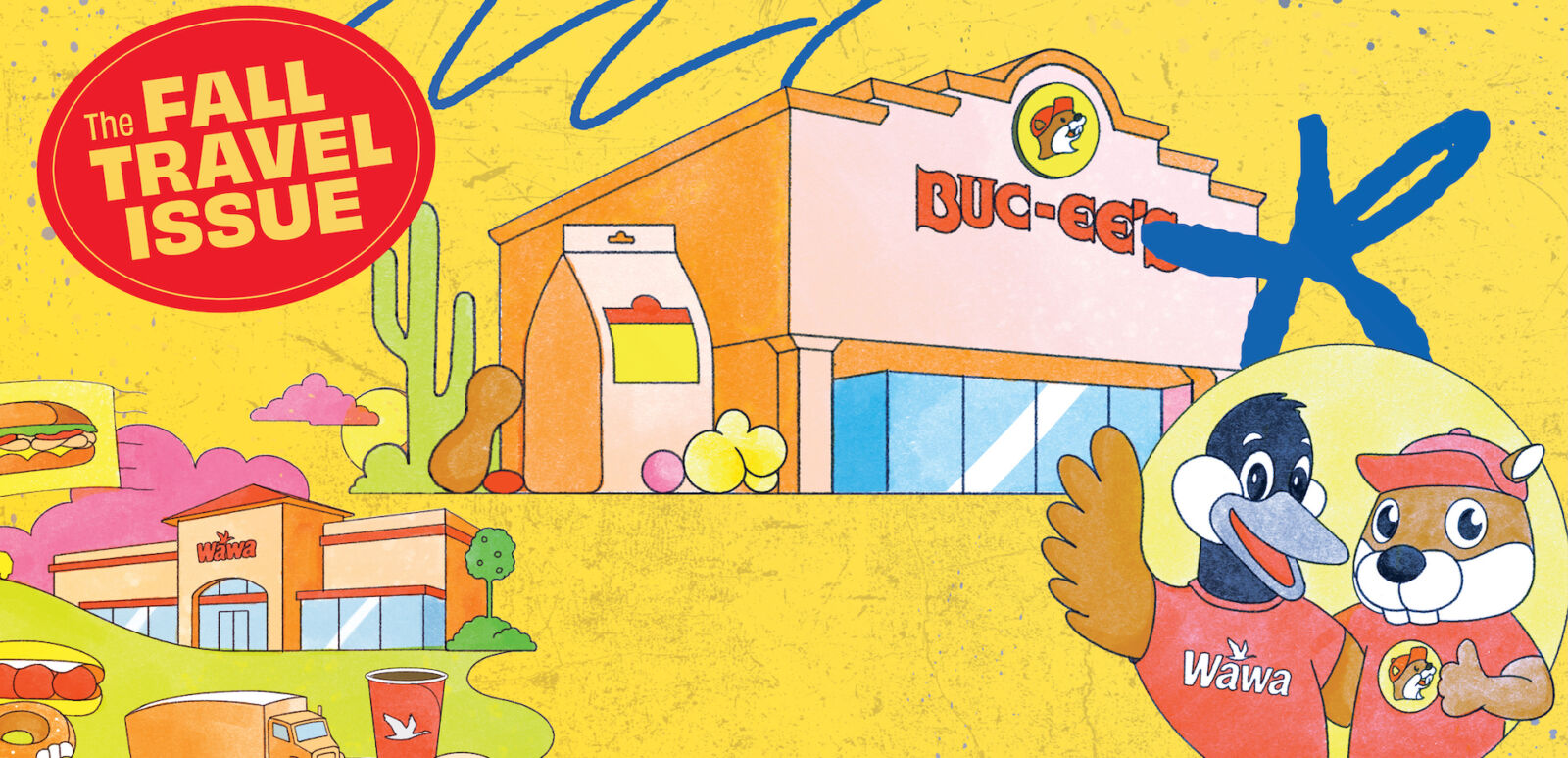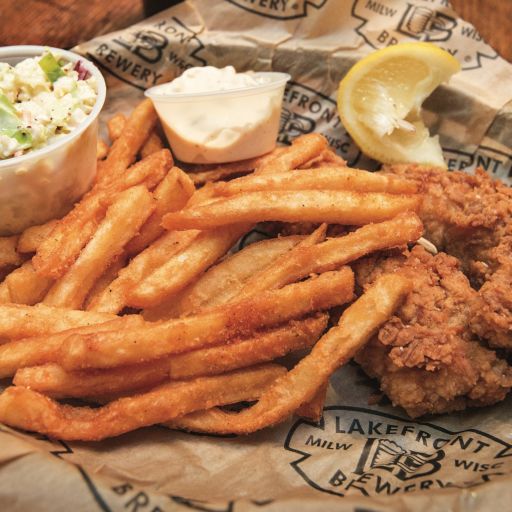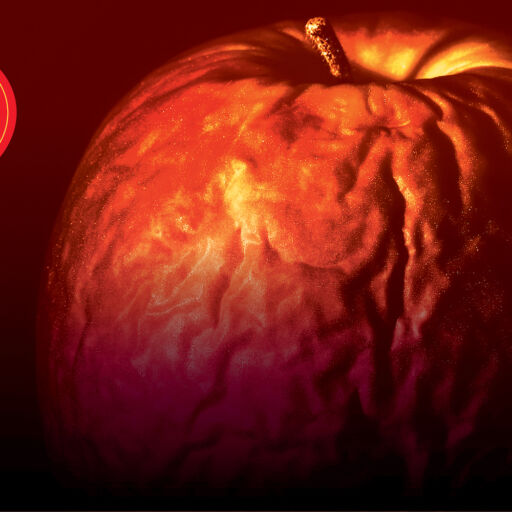This story is part of the Fall Travel issue, which is on sale here.
Every great road trip movie will present you with the same fantasy: the country flashing by in a whirl of changing landscapes, a clever condensing of the passage of time. What they don’t show you are the breaks between state lines. The snack cravings. The prayers whispered for a bathroom to appear in the next five miles. There is nothing particularly glamorous about rest stops: the places we stop on the road when we need to rest, refuel or, in my case, be violently ill in a parking lot after seeing Weezer perform.
More than an interlude, for travelers, these locations are museums of the states they occupy. Rest stops, particularly those unfamiliar to us, are like interactive art exhibits, artifacts from a large, sprawling state gathered and held in one building (the Louvre also has bathrooms). They are filled with idols and deities, political statements and firm indications of a state’s culture, like food. A rest stop is the place to get a sense of the state you’ve just entered. After all, as the great writer Ralph Waldo Emerson once said about adventuring in the unknown: “Do not follow where the path may lead. Go instead where there is no path and leave a trail” …of toilet paper.
From a purely aesthetic perspective, the infrastructure of a rest stop is entirely dependent on location. On the East Coast, the only sign of I-95 changing in its slow climb to Maine is the morphing shapes of the rest stops that dot the highway, starting from palm-tree-lined, squat structures in Florida to the colonial houses of New England. Whereas in the deserts of California and the Southwest, rest stops are designed to provide relief from an overbearing sun; shaded oases built into the landscape.
In sociology, these structures could be considered “cultural objects,” which sociologist Wendy Griswold defined in the 1980s as “shared significance embodied in form.” Emphasis on the shared part. Approaching New York City from the south, a new billboard on the Jersey Turnpike has turned a few heads online. The sign offers only a U-turn symbol and “581 Miles” to the nearest Buc-ee’s, a name that means nothing to a lifelong East Coast resident or a Midwesterner. To millions of Southerners, however, that little icon of the Buc-ee’s beaver is a cultural emblem as revered as any sports team mascot.
These superstore-like locations look like a 7-Eleven and Walmart had a baby, with rows and rows of convenience store snacks followed by hot food and merchandise, much of which bear the beaver’s face. You can purchase Beaver Nuggets (Buc-ee’s signature sugar-coated corn snacks), shirts, hats, onesies, plushies, kolaches, dog collars, even barbecue grills. Texas Highways calls it “an intentionally overwhelming, astonishing temple of mass consumption.”
Buc-ee’s tells you a lot about its home base. The second-largest state in the country, Texas is all about emphasizing its own swagger and size. Since opening its first location outside of Texas in 2019, the chain has invaded seven nearby states. In December 2022, just one superstore location in Georgia was visited by an average of more than 11,700 cars per day. The largest Buc-ee’s location, opened in 2023 in Sevierville, Tenn., is 74,000 square feet. That location alone has 120 gas pumps on site. You know what they say: everything’s bigger in Texas. Even when it franchises outside of Texas.
Buc-ee’s is frequented by tourists and locals, some of whom do some of their food shopping there. French writer Annie Ernaux wrote about supermarkets as places where culture was on full display. “I believe that desire, frustration and social and cultural inequality are reflected…in anything that appears to be unimportant and meaningless simply because it is familiar or ordinary… thus a supermarket can provide just as much meaning and human truth as a concert hall.” And so can a $1,000 branded barbecue pit.
New Hampshire, for instance, is home to folksy farmhouse-style rest stops. The pace is slow, no one is in the rush they would be outside of Boston or New York, homemade jam is sold, people are kind and welcoming but mind their own business. You can buy alcohol tax-free as soon as you cross state lines: the state’s motto, Live Free or Die, in action. While Buc-ee’s sells prepackaged goods en masse, you’re more likely to find a smaller quantity of handmade items the further you drive into New Hampshire, Vermont or Maine. Quality over quantity.
On the contrary, with almost 50 locations and counting, Buc-ee’s is spreading disciples of the Beaver-Nugget-eating-truck-hat-wearing church across the United States. Within the next few years, the chain plans to open stores in Mississippi, Wisconsin, Ohio and Virginia. Virginia’s Governor Glenn Youngkin went so far as to say “There’s nothing like it in America.”
One state where Buc-ee’s has been unable to get a foothold is New Jersey — one of two states in the country where it is illegal to pump your own gas. A common annoyance and source of bewilderment for visitors, having the job done for you is part of Jersey culture, where on the turnpike, you may see a popular bumper sticker: “Jersey Girls Don’t Pump Gas.” Buc-ee’s has failed to bloom in the Garden State because Wawa already has New Jersey in a chokehold.
Wawa, at least on its face, is a roadside convenience store like many others, if convenience stores were run by, say, Jersey Mike’s. Part upscale 7-Eleven, part deli, it is not uncommon in New Jersey to be asked if you want to go to Wawa on purpose, not as a stop on the way to another location. It’s not their size that makes them stand out, but their quality, especially of food and interactions. Many New Jersey homes even keep a pint of Wawa milk in the fridge over a grocery store equivalent. And, as said by New Jersey high school student Thomas Tait: “Wawa is a unique place in New Jersey. The attitude of the state usually remains bustling and aggressive, yet Wawa is a refuge from it all. It’s one of the few places in New Jersey where people hold the door for you when you have too many hoagies and unhealthy amounts of lemon ice-tea; and say, ‘Thank you!’ when you reciprocate the favor.” Doesn’t that just bring tears to your eyes?
Delaware is the beginning of Wawa country. If you don’t hail from the mid-Atlantic — or even if you do — you may think there is very little difference between Maryland and Delaware. But Wawa doesn’t mean shit to Marylanders. It does to the folks in Delaware, in part, because so many there resonate culturally with Philadelphia. When I first moved to Philadelphia, I was shocked to find a Wawa adjacent to City Hall — sans gas station pump — and even more shocked to be invited to dine there. Pennsylvanians and New Jerseyians love a sandwich, and they like things to be done efficiently. And Wawa is as straightforward as these constituents: you can even get your Thanksgiving dinner on a hoagie.
Unlike Buc-ee’s, Wawa fandom has been created without any real push from the storefront itself. The chain does not sell aisles upon aisles of its own merchandise, but it’s still common to see stickers bearing “Live.Love.Wawa.” on cars, laptops and water bottles. Not many people know this, but it was Wawa that inspired state treasure Bruce Springsteen’s Jersey Turnpike anthem:
“Mister state trooper, please don’t stop me
Please don’t stop me, please don’t stop me
I’ve got a date with a BLT hoagie”
From the red wings of the Wawa bird (the name Wawa comes from the Native American Ojibwe word for the Canadian goose) to that capped rodent currently running Texas, the notability and ubiquitousness of stores in certain regions have made rest stop logos revered in the same way famous paintings are. Just like a Van Gogh, they are instantly recognizable, often on an emotional level. The images are signifiers for those in the know and odd art objects for those not. In Griswold’s interpretation, logos are “tokens” entirely dependent on their cultural context to hold meaning. What art could better speak to Americans than that of a regional corporate deity? It can tell you everything you need to know about the world you’ve driven into.




